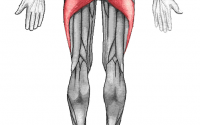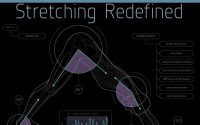Fascia: Structure, Function, and Therapeutic Insights for Musculoskeletal Health and Sports Performance
Fascia is a widespread connective tissue in the human body that surrounds and permeates muscles, bones, blood vessels, nerves, and internal organs. Fascia plays crucial roles in posture, movement, and maintaining bodily functions, and it contains sensory receptors for proprioception, nociception, and hormones.
A review article published in Bioengineering journal provides an overview of the role of fascia in musculoskeletal health and sports performance, highlighting its mechanical properties and responses to physiological challenges, while also discussing potential therapeutic approaches.
Role of fascial tissues
Structurally, fascial tissues consist of various cell types, fibrous components (collagen fibers, elastin, fibrillin), aqueous components (water and glycosaminoglycans), and neural elements (nerve endings and mechanoreceptors).
Fascia can distribute forces and tension throughout the body, influencing muscle coordination and reflecting force vectors’ directions. It can also actively contract, primarily due to myofibroblasts, which differentiate from fibroblasts in response to mechanical stress. Myofibroblasts form actin stress fibers and adhesion complexes that connect with the extracellular matrix (ECM) and generate contractile forces. Chronic strain, such as sitting for extended periods, muscle overuse, infection, inflammation, and limb immobilization, can further contribute to myofibroblast contraction and joint issues.
The exact balance between exercise and rest in maintaining fascial health remains uncertain, but repeated cycles of contraction can lead to irreversible tissue contraction.
Factors Influencing the Development of Fascia Tissue
Fascia is recognized as the largest sensory organ, yet its innervation varies across different body parts, highlighting its complexity. These sensory aspects also imply that structural changes in fascial tissues can stimulate free nerve endings, potentially exacerbating inflammation and pain. Inflamed thoracolumbar fascia is associated with an increase in nociceptors. Repetitive postures, sports, and motion patterns can affect fascial thickness and limit sliding between fascial layers. Structural changes due to trauma, overuse, or surgery can also impact nerve receptors in the fascia.
Mechanical stress plays a pivotal role in the transformation of fibroblasts into myofibroblasts, contributing to tissue tension and contractility. Prolonged mechanical strain, such as from sitting, overuse, trauma, or inflammation, can lead to persistent contraction of myofibroblasts, causing joint issues. Inflammatory responses in fascial tissues can result from mechanical stress, releasing cytokines and causing tissue damage. The presence of cytokines can lead to nociceptive afferent nerve sensitization and further production of substances that promote fibrosis. This intricate relationship between mechanical stress, inflammation, and fibrosis underscores the complexity of managing myofascial tissue injuries.
Aging introduces its own set of challenges as fascia undergoes changes that affect mobility and pain. Physical inactivity can exacerbate these changes by altering collagen, limiting fascial sliding, and increasing myofibroblast activity. This can lead to pain and reduced muscle strength, which cannot be solely attributed to muscle mass loss. Additionally, the composition and thickness of fascia vary with age, impacting joint flexibility and force transmission within the locomotor system.
Hyaluronic acid (HA) emerges as a significant player in fascial biomechanics. HA facilitates sliding between deep fascia and muscles, promoting smooth motion. However, changes in HA concentration and viscosity, influenced by factors like exercise and immobility, can impact fascial flexibility. Strategies to modify HA properties, such as temperature, pH adjustments, and mechanical loading, may offer avenues for addressing fascial discomfort and stiffness. Overall, understanding the multifaceted nature of fascial tissues is vital for addressing a wide range of musculoskeletal issues and promoting overall well-being.
Myofascial degeneration can occur due to various factors, including circulatory issues from trauma or reduced physical activity, disuse syndrome, overuse syndrome from repetitive movements, and chronic poor posture. These factors lead to the densification of fascia, characterized by twisted collagen fibers and dehydration-induced hardening of the tissue. Overuse syndrome, in particular, can cause hyaluronic acid aggregation, reducing fascial sliding properties.
Dysfunction in one part of the fascia can lead to stress in other areas due to the continuity of the fascial structure. This limitation in fascial gliding can impair posture maintenance, athletic performance, and daily activities. Athletes often face the challenge of finding the right balance between training and rest. Inadequate recovery periods can lead to high-frequency, high-intensity training, resulting in overuse injuries.
Role of Myofascial release
Myofascial release (MFR) techniques aim to improve myofascial tissue mobility and length, alleviating pain and restoring normal function. MFR can be administered by professionals or through self-myofascial release (SMFR) using methods like foam rolling (FR). FR has been shown to reduce muscle soreness, increase pain thresholds, and improve range of motion without decreasing exercise performance.
MFR has been applied to treat various conditions, including tension-type headaches, venous insufficiency, and chronic low back pain. It is considered safe and applicable across age groups and diseases.
Self MFR is increasingly used to prevent injuries and enhance performance in sports. It can reduce delayed-onset muscle soreness (DOMS) and improve vascular function, blood flow, and oxygen supply to muscles. SMFR can be beneficial when performed both before and after exercise, promoting flexibility, reducing fatigue, and enhancing performance. It may also help prevent fascial adhesions and reduce injury risk in athletes.
While various manual therapies exist for myofascial issues, such as osteopathic soft tissue techniques, strain counterstrain, myofascial trigger point therapy, and muscle energy techniques, there is a need for further research to determine which approach is optimal. Additionally, more studies are required to establish the clinical significance of MFR in different conditions and patient populations, ultimately building a stronger evidence base for its effectiveness.
Top of Form

